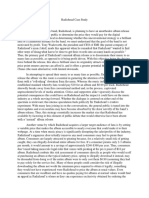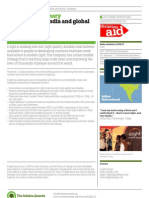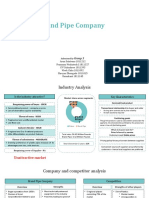Radiohead Memo Case Analysis
Radiohead Memo Case Analysis
Uploaded by
sanchezeyeCopyright:
Available Formats
Radiohead Memo Case Analysis
Radiohead Memo Case Analysis
Uploaded by
sanchezeyeOriginal Title
Copyright
Available Formats
Share this document
Did you find this document useful?
Is this content inappropriate?
Copyright:
Available Formats
Radiohead Memo Case Analysis
Radiohead Memo Case Analysis
Uploaded by
sanchezeyeCopyright:
Available Formats
Conclusion In my opinion, this was a good and innovative strategy that came out of the traditional model used
used by major record
companies. Radiohead did something unique and different that could bring it many benefits both musically and
financially for the following reasons:
By not being tied to a contract with a record label, I can infer that the band did not have to share
profits with middlemen
Costs for distribution channels would be minimal when using the Radiohead’s website
Even people paying zero had to pay a service fee which I presume is sufficient to prevent them
losing money on downloads
By offering a $40 CD box edition pre-order, the band would attract the serious fan market with
something more expensive than a typical CD offering, and pre-ordering allows it to size the
production run so the band won't lose money
Background Radiohead is an English rock band formed in 1985. It was one of the most popular and artistically significant
contemporary bands of the late 20th and 21st centuries. Between 1993 and 2003 the band released six albums that
earned it a huge success among its followers and a reputation for experimenting with unconventional album release
tactics. By 2003, the contract with EMI ended and the band decided not to renew it. By 2005, the band began to
record its seventh album In Rainbows, which was self-produced and self-released by Radiohead. Without a recording
contract, the band was free to release its music when it wanted to and how it wanted to. By 2007, Radiohead’s
website announced the release of In Rainbows, in unusual but attractive way. The album would be available
exclusively through its website for digital download, but consumers would have the option to decide their own price
for it.
Case Issue The band Radiohead announced it would allow customers to decide how much to pay for its new album, released
exclusively as a digital download and available only from the band's own web site. Was the plan a good idea? And
how this strategy would impact the music industry?
Analysis The strategy for the release of this album seems to be unprofitable but attractive for customers. The highly unusual
plan represented a significant break from the industry standard of fixes prices for music (typically $0.99 for
individual digital song and $9.99 or more for complete albums). However, by not including a percentage of profit for
the record company, the product's price could drop substantially. Also, considering the popularity of the band, there
were thousands of potential buyers who are willing to pay or get for a copy and the possibilities were:
Setting price as low as possible even equals to zero dollar.
Setting a price buyers consider “fair” value.
Setting a price above the “fair” value.
The first one would create profit in the future when potential buyers who have bought the album without paying any
dollar are likely to buy the next album or recommend it to friends. If the second and third possibility happens the
profits could be high. Also, lower price could mean higher profit because buyers will buy more of the product as a
result of a low price.
Take away The music industry is being forced to transform its business models and distribution strategies to sustain market share
and create new revenue sources. The increase in digital content, number of new distribution channels– a result of
rising Internet penetration, shifting demographics and changing consumption habits– is having a dramatic impact on
the industry supply chain and the current structure appears inadequate. Industry players, therefore, should adjust their
existing processes by adopting cost reduction initiatives and introducing new business strategies, as name your own
price sale and digital distribution, to remain competitive.
MEMO Re: Radiohead: Music at your own price
You might also like
- The Value of Brand EquityDocument7 pagesThe Value of Brand Equitykash81150% (4)
- San Francisco Coffee House - Case AnalysisDocument10 pagesSan Francisco Coffee House - Case AnalysisGaurav Kumar0% (1)
- Document 2Document3 pagesDocument 2Kartik100% (1)
- JC Penney - Fair & SquareDocument8 pagesJC Penney - Fair & SquareBhushanbm0% (1)
- Radiohead Case StudyDocument2 pagesRadiohead Case StudyFrank100% (1)
- CaseStudy RadioheadDocument3 pagesCaseStudy RadioheadLavanya GunalanNo ratings yet
- Symbian, Google and Apple in The Mobile SpaceDocument8 pagesSymbian, Google and Apple in The Mobile SpacerapidraviNo ratings yet
- D.light Case StudyDocument4 pagesD.light Case StudySatya Sundeep TNo ratings yet
- MoS Section A - Group 8 - Case3Document3 pagesMoS Section A - Group 8 - Case3Vatsal MaheshwariNo ratings yet
- Kimura Case AnalysisDocument3 pagesKimura Case Analysisladiez_magnet100% (1)
- DocxDocument14 pagesDocxJh Junior100% (1)
- B2B Term PaperDocument8 pagesB2B Term PaperSamyukt AgrawalNo ratings yet
- Case HyruleDocument3 pagesCase HyrulePepito PerezNo ratings yet
- Zipcar AnalysisDocument13 pagesZipcar Analysis15pgp086.manishNo ratings yet
- Dewdrop Soap Partha Sarathi Minz PC20200442Document1 pageDewdrop Soap Partha Sarathi Minz PC20200442Shyamal VermaNo ratings yet
- MDCM, Inc. (A) : IT Synchronization StrategyDocument5 pagesMDCM, Inc. (A) : IT Synchronization StrategyTalha MehmudNo ratings yet
- AI Module 2Document47 pagesAI Module 2Nithin KsNo ratings yet
- BBS Project On KhajuricoDocument36 pagesBBS Project On KhajuricoAlisha Nakkali79% (43)
- Investment Banking Preparation Week 1Document12 pagesInvestment Banking Preparation Week 1daniel18ctNo ratings yet
- MARK 502 - Omnichannel RetailingDocument5 pagesMARK 502 - Omnichannel RetailingShivaniNo ratings yet
- Prof. Debashish Pradhan: Consumer BehaviourDocument3 pagesProf. Debashish Pradhan: Consumer BehaviourShivam Garg100% (1)
- Case-Commerce Bank: Submitted By, Debarghya Das PRN No.18021141033Document5 pagesCase-Commerce Bank: Submitted By, Debarghya Das PRN No.18021141033Rocking Heartbroker DebNo ratings yet
- J K Wedding DanceDocument3 pagesJ K Wedding DanceDiv KabraNo ratings yet
- TiVo in 2002Document18 pagesTiVo in 2002Gaurav Agarwal100% (1)
- Samantha Seetaram IENG3003 Assignment1Document15 pagesSamantha Seetaram IENG3003 Assignment1Samantha SeetaramNo ratings yet
- Case 7 - D Lights Marketing Channel V3 1Document20 pagesCase 7 - D Lights Marketing Channel V3 1KshitijNo ratings yet
- Case Analysis ASPDocument4 pagesCase Analysis ASPabhishekNo ratings yet
- RKS Guitars AnalysisDocument6 pagesRKS Guitars AnalysisSiddhesh GandhiNo ratings yet
- Verklar Austria CaseDocument15 pagesVerklar Austria Caseydchou_690% (2)
- Business Analytics-Bharti Airtel: Group 7 Members: Rajani Nair Akansha Dwivedi Moumita Basak Jayasekharan UnnikrishnanDocument7 pagesBusiness Analytics-Bharti Airtel: Group 7 Members: Rajani Nair Akansha Dwivedi Moumita Basak Jayasekharan UnnikrishnanRajani Nair (PGPMX-2019 Batch 1)No ratings yet
- Consumer Perception On Super ShampooDocument16 pagesConsumer Perception On Super ShampooAmit BhalaniNo ratings yet
- Computron IncDocument7 pagesComputron IncJD_04100% (1)
- Black & Decker Case SolutionDocument9 pagesBlack & Decker Case SolutionJesus Manuel SánchezNo ratings yet
- Harvard Business School Kone The MonoSpace Launch in Germany RDocument3 pagesHarvard Business School Kone The MonoSpace Launch in Germany RmichaelNo ratings yet
- Fair and Square Case - JC Penny - 1Document7 pagesFair and Square Case - JC Penny - 1Rahul Jain0% (1)
- Bbva CRMDocument8 pagesBbva CRMSavitha Bhaskaran0% (2)
- Brand Expolatory and ZMET TechniqueDocument8 pagesBrand Expolatory and ZMET TechniqueShilpa SharmaNo ratings yet
- Product Proliferation and Preemption Strategy SupplementsDocument22 pagesProduct Proliferation and Preemption Strategy SupplementstantanwyNo ratings yet
- Cottle-Taylor Expanding The Oral Care Group in India Group-6Document17 pagesCottle-Taylor Expanding The Oral Care Group in India Group-6ayush singlaNo ratings yet
- Shradh - Basic Information On Shraddha Rituals and CeremonyDocument2 pagesShradh - Basic Information On Shraddha Rituals and CeremonyVenkata Subba Rao J0% (2)
- Chotukool SubmissionDocument8 pagesChotukool SubmissionLife After BookNo ratings yet
- J.C. Penney's "Fair and Square" Pricing StrategyDocument6 pagesJ.C. Penney's "Fair and Square" Pricing StrategySachin KandloorNo ratings yet
- Business Policy Mba-Ii: Beech-Nut Nutrition CorporationDocument3 pagesBusiness Policy Mba-Ii: Beech-Nut Nutrition CorporationmsaadnaeemNo ratings yet
- Big Skinny Analysis PDFDocument8 pagesBig Skinny Analysis PDFfaewfw100% (2)
- Pepsi Lipton Brisk Case Analysis - Group - VIIDocument3 pagesPepsi Lipton Brisk Case Analysis - Group - VIIGunjan MaheshwariNo ratings yet
- B2B Brand Pipe-2Document10 pagesB2B Brand Pipe-2IIMB SumitNo ratings yet
- Ingersoll-Rand - Sec X - Group 5Document2 pagesIngersoll-Rand - Sec X - Group 5Chinmay MohapatraNo ratings yet
- American Well: The Doctor Will E-See You Now - CaseDocument7 pagesAmerican Well: The Doctor Will E-See You Now - Casebinzidd007No ratings yet
- JWT ChinaDocument7 pagesJWT ChinaNikhil SharmaNo ratings yet
- GoodYear Group 6Document27 pagesGoodYear Group 6Kavi SunejaNo ratings yet
- Base CampDocument1 pageBase CampPranav TyagiNo ratings yet
- Criticism On EDS - 1703029 - ShaurabhDocument2 pagesCriticism On EDS - 1703029 - Shaurabhsabey22991No ratings yet
- Goodyear AquatredDocument2 pagesGoodyear AquatredSaloniNo ratings yet
- Hubspot: Inbound Marketing and Web 2.0: Market Research For A New Product IntroductionDocument4 pagesHubspot: Inbound Marketing and Web 2.0: Market Research For A New Product IntroductionAnimesh ChakrabortyNo ratings yet
- GE We Bring Good Things To Life - Case Study AssignmentDocument4 pagesGE We Bring Good Things To Life - Case Study AssignmentPyle StyleNo ratings yet
- Wesco Distribution IncDocument2 pagesWesco Distribution IncJiswanath MondalNo ratings yet
- Classic Case SolutionDocument5 pagesClassic Case Solutionbinzidd007100% (1)
- Aakash Book Store-0 RetailDocument9 pagesAakash Book Store-0 RetailHarikrishnan SpNo ratings yet
- Report 1 Other DivDocument5 pagesReport 1 Other DivKT MirashNo ratings yet
- Pricing Dilemma - Pricing Strategy - EMBA Global 2012 - David BrunDocument9 pagesPricing Dilemma - Pricing Strategy - EMBA Global 2012 - David BrunDavid BrunNo ratings yet
- Radiohead: Music at Your Own Price: Presented by Group 2Document6 pagesRadiohead: Music at Your Own Price: Presented by Group 2ANSHUL GARGNo ratings yet
- Econ Paper 103Document34 pagesEcon Paper 103KrudergreenNo ratings yet
- Case Study - RadioheadDocument2 pagesCase Study - RadioheadSabeeh -ul -Hassan100% (1)
- Eco1 MODULE 3Document4 pagesEco1 MODULE 3「No I D E A」No ratings yet
- Derivatives MarketDocument18 pagesDerivatives MarketJishnuPatilNo ratings yet
- MKT626Chap15 16thedDocument16 pagesMKT626Chap15 16thedSaurabh AroraNo ratings yet
- Quiz IiiDocument2 pagesQuiz IiiLanCicakNo ratings yet
- Name: Vienna Jhane G. Mamaril Section: Bsa 1B: Queuing NeedsDocument2 pagesName: Vienna Jhane G. Mamaril Section: Bsa 1B: Queuing NeedsVienna MamarilNo ratings yet
- El Impacto de Las Ordenes IcebergDocument3 pagesEl Impacto de Las Ordenes IcebergJacobo VillaNo ratings yet
- Porter 5 ForcesDocument6 pagesPorter 5 Forcesapi-3716002100% (3)
- Kotler Mm15e Inppt 13Document25 pagesKotler Mm15e Inppt 13minhkhanhwm2203No ratings yet
- Institute of Actuaries of India: ExaminationsDocument10 pagesInstitute of Actuaries of India: Examinationsmanojbhatia1220No ratings yet
- ESM Week 1 - SummaryDocument8 pagesESM Week 1 - SummaryriyaNo ratings yet
- W1 Defining Financial TermsDocument6 pagesW1 Defining Financial TermsSuzie TaingNo ratings yet
- PRINCIPLES OF BUSINESS DECISIONS Short NotesDocument71 pagesPRINCIPLES OF BUSINESS DECISIONS Short Notespcmia40No ratings yet
- Traditional Marketing vs. Digital Marketing: Aim: The Purpose of This Study Is Simply ToDocument4 pagesTraditional Marketing vs. Digital Marketing: Aim: The Purpose of This Study Is Simply ToArihant Jain KNo ratings yet
- What Is Invesment BankDocument4 pagesWhat Is Invesment BankAntonio QuirozMaganNo ratings yet
- Course Outline 2Document3 pagesCourse Outline 2sinicynaalisaNo ratings yet
- Entrepreneurship Quarter Iii Week 7 Develop A Brand NameDocument1 pageEntrepreneurship Quarter Iii Week 7 Develop A Brand NameSamantha AlzateNo ratings yet
- ASM A1 StarbucksDocument2 pagesASM A1 Starbucksfaraz ahmad khanNo ratings yet
- Final Marketing Strategies For New Market EntriesDocument29 pagesFinal Marketing Strategies For New Market EntriesAmit ShrivastavaNo ratings yet
- CorrectDocument79 pagesCorrectSujainNo ratings yet
- Test BankDocument7 pagesTest BankChristian Josué RecinosNo ratings yet
- MarketingDocument12 pagesMarketingmsampathramanujaNo ratings yet
- Pricing Strategies For Firms With Market PowerDocument33 pagesPricing Strategies For Firms With Market PowerIkrame KiyadiNo ratings yet
- AIOU Assignment 402Document4 pagesAIOU Assignment 402ziabuttNo ratings yet
- E-Marketing Sebagai Paradigma Baru Dalam Komunikasi PemasaranDocument13 pagesE-Marketing Sebagai Paradigma Baru Dalam Komunikasi PemasaranHadnanHardiansyahNo ratings yet
- Review of Literature For Foreign Exchange or ForexDocument2 pagesReview of Literature For Foreign Exchange or Forexrajesh bathula100% (1)
- Syllabus Item: 82 Weight: 3: 2.2 Aggregate Demand and Supply - Aggregate Demand (AD)Document32 pagesSyllabus Item: 82 Weight: 3: 2.2 Aggregate Demand and Supply - Aggregate Demand (AD)George EscribanoNo ratings yet

























































































